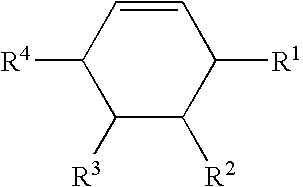Methods for inhibiting corrosion in brazed metal surfaces and coolants and additives for use therein
a technology of brazed metal and additives, which is applied in the direction of electrically conductive generators, fire extinguishers, cooking vessels, etc., can solve the problems of inability to inhibit corrosion, waste of energy from deceleration as it dissipates, and undesirable high-weight vehicle components, etc., to achieve the effect of inhibiting corrosion
- Summary
- Abstract
- Description
- Claims
- Application Information
AI Technical Summary
Benefits of technology
Problems solved by technology
Method used
Image
Examples
examples
[0100] Experimental data showing the benefits of using the instant invention are described in the example below.
[0101] Table 1 shows the results of solution analysis of fluoride concentrations in various coolant formulations after exposing to a Nocolok flux brazed aluminum sample and after conducting anodic polarization curve measurements on the sample while immersing in the coolants.
TABLE 1Fluoride Concentration After Electrochemical Tests on BrazedAluminum Sample with Nocolok flux, 1 time flux loading at 20-25%concentration.FluorideCoolant ID(mg / L)ObservationCoolant Composition 15690% surface area were attackedCoolant Composition 20Surface (AA3003) showed minimalattackCoolant Composition 37Surface showed very minor attackCoolant Composition 416Surface showed minor attack,particularly under o-ring creviceCoolant Composition 5Surface showed no noticeable attackCoolant Composition 6113Surface attacked intensivelyCoolant Composition 726Surface showed isolated localized attack
[0102]...
PUM
| Property | Measurement | Unit |
|---|---|---|
| electrical conductivity | aaaaa | aaaaa |
| cell voltage | aaaaa | aaaaa |
| conductivity | aaaaa | aaaaa |
Abstract
Description
Claims
Application Information
 Login to View More
Login to View More - R&D
- Intellectual Property
- Life Sciences
- Materials
- Tech Scout
- Unparalleled Data Quality
- Higher Quality Content
- 60% Fewer Hallucinations
Browse by: Latest US Patents, China's latest patents, Technical Efficacy Thesaurus, Application Domain, Technology Topic, Popular Technical Reports.
© 2025 PatSnap. All rights reserved.Legal|Privacy policy|Modern Slavery Act Transparency Statement|Sitemap|About US| Contact US: help@patsnap.com



